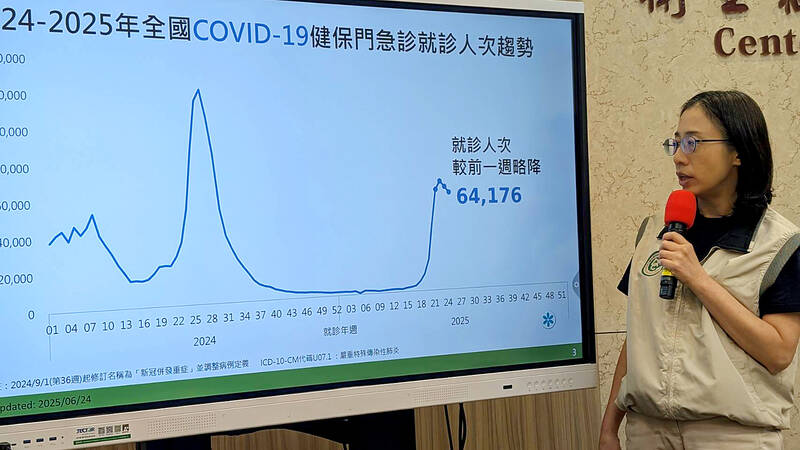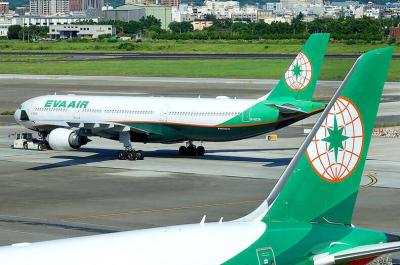Two imported cases of chikungunya fever were reported last week, raising the total this year to 13 cases — the most for the same period in 18 years, the Centers for Disease Control (CDC) said yesterday.
The two cases were a Taiwanese and a foreign national who both arrived from Indonesia, CDC Epidemic Intelligence Center Deputy Director Lee Chia-lin (李佳琳) said.
The 13 cases reported this year are the most for the same period since chikungunya was added to the list of notifiable communicable diseases in October 2007, she said, adding that all the cases this year were imported, including 11 from Indonesia.

Photo: CNA
Regarding global chikungunya activity, Lee said it is most severe in South America, with Brazil having reported more than 170,000 cases so far this year, and in Asia, virus activity is rising in Indonesia, where its health ministry has issued an alert.
The two cases reported last week were detected as having a fever at a CDC quarantine station upon their arrival in Taiwan, and they later tested positive for chikungunya fever, CDC physician Lin Yung-ching (林詠青) said.
Like dengue fever and Zika fever, chikungunya fever is a viral illness mainly spread to humans through infected Aedes mosquitoes, he said.
The diseases share similar symptoms, such as fever, headache, muscle and joint pain, but about 70 percent of people with chikungunya might develop severe and prolonged joint pain, Lin said.
People traveling to places where chikungunya fever is spreading should take precautions against mosquito bites, and if they develop suspected symptoms within 14 days after returning to Taiwan, they should seek medical attention and inform their doctor of their recent travel history, he said.
Meanwhile, enterovirus activity rose slightly last week, with 6,772 hospital visits, while viral surveillance data showed that echovirus 11 was the dominant strain circulating locally in the past four weeks, Lee said.
The rate of enterovirus infections in northern Taiwan last week was more significant than in other parts of the country, and a severe case was reported in a four-year-old girl in the north, she said.
The child began experiencing cold-like symptoms late last month and was taken to a clinic and a hospital, but about two weeks later she developed lower limb pain, which slightly subsided after she was again taken to a clinic, Lin said.
However, three days later she developed back pain and was unable to squat, so she was hospitalized and later admitted to an intensive care unit after examinations found she had abnormal nerve signals and was suspected of having myelitis, he said, adding that she was diagnosed with acute flaccid paralysis and echovirus 11.
The girl’s condition improved after treatment and she was expected to be discharged from hospital yesterday, he added.
It is relatively rare for an echovirus 11 infection to cause acute flaccid paralysis, as the symptom is more often associated with enterovirus D68 infection, CDC Deputy Director-General Philip Lo (羅一鈞) Lo said.
Only four previous cases of echovirus 11 infection leading to acute flaccid paralysis have been reported in Taiwan, with the previous one reported in 2018, he said.
Although acute flaccid paralysis is rarely fatal with proper treatment, it can cause lasting side effects, so caregivers should help prevent enterovirus infection in children by frequently washing hands with soap and regularly disinfecting the living environment, he said.
Moreover, hospital visits for enterovirus slightly increased in central and southern Taiwan, and fell in Kaohsiung and Pingtung County, he said, adding that parents of young children, especially newborns, in northern Taiwan should pay extra attention.
The CDC also said that hospitals reported 64,176 visits for COVID-19, including 117 severe cases and 39 related deaths.
While cases are slightly falling, COVID-19 activity remains at a relatively high level, it said.

The first global hotel Keys Selection by the Michelin Guide includes four hotels in Taiwan, Michelin announced yesterday. All four received the “Michelin One Key,” indicating guests are to experience a “very special stay” at any of the locations as the establishments are “a true gem with personality. Service always goes the extra mile, and the hotel provides much more than others in its price range.” Of the four hotels, three are located in Taipei and one in Taichung. In Taipei, the One Key accolades were awarded to the Capella Taipei, Kimpton Da An Taipei and Mandarin Oriental Taipei. Capella Taipei was described by

The Taichung District Court yesterday confirmed its final ruling that the marriage between teenage heir Lai (賴) and a man surnamed Hsia (夏) was legally invalid, preventing Hsia from inheriting Lai’s NT$500 million (US$16.37 million) estate. The court confirmed that Hsia chose not to appeal the civil judgement after the court handed down its ruling in June, making the decision final. In the June ruling, the court said that Lai, 18, and Hsia, 26, showed “no mutual admiration before the marriage” and that their interactions were “distant and unfamiliar.” The judge concluded that the couple lacked the “true intention of

EVA Airways today confirmed the death of a flight attendant on Saturday upon their return to Taiwan and said an internal investigation has been launched, as criticism mounted over a social media post accusing the airline of failing to offer sufficient employee protections. According to the post, the flight attendant complained of feeling sick on board a flight, but was unable to take sick leave or access medical care. The crew member allegedly did not receive assistance from the chief purser, who failed to heed their requests for medical attention or call an ambulance once the flight landed, the post said. As sick

INDUSTRY: Beijing’s latest export measures go beyond targeting the US and would likely affect any country that uses Chinese rare earths or related tech, an academic said Taiwanese industries could face significant disruption from China’s newly tightened export controls on rare earth elements, as much of Taiwan’s supply indirectly depends on Chinese materials processed in Japan, a local expert said yesterday. Kristy Hsu (徐遵慈), director of the Taiwan ASEAN Studies Center at the Chung-Hua Institution for Economic Research, said that China’s latest export measures go far beyond targeting the US and would likely affect any country that uses Chinese rare earths or related technologies. With Japan and Southeast Asian countries among those expected to be hit, Taiwan could feel the impact through its reliance on Japanese-made semi-finished products and